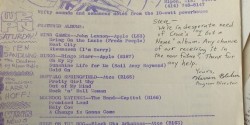It can be challenging to track down the history of specific college radio stations and I often find interesting tidbits while doing online research. In the course of my research, I ran across a couple of sources from the early 1970s that point to the state of college radio at the time. As I’m ensconced at the Radio Preservation Task Force conference today, it seemed like a great opportunity to share some 1970s-era college radio history nuggets for today’s College Radio Watch.
College Radio in 1971: Popular Place to Break New Material
The “Campus News” section of the February 6, 1971 issue of Billboard features the article “College Radio: A Movement That’s Earning Its (Call) Letters.” In the piece, Jim Cameron (then the Program Director of Lehigh University’s WLVR and WLVR-FM) praises college radio, saying:
Despite what some people would have you believe, College Radio has accomplished a great deal more in its 30-year history than just being daring enough to play ‘Je T’aime.’ And even though some of its work may sound a little unprofessional, in the long run, College Radio is providing a tremendous service not only to the communications media in general, but also to the millions of college students across the country that turn to what they consider to be their stations for music, news and information.”
The same article references estimates at the time that “from 40 to 50% of all college students listen to their campus radio stations…a claim which very few commercial stations can make.”
The Billboard piece argues that college radio stations have greater programming freedom and that they have a “reputation…as being the place to ‘break’ new material…College underground stations…are really in the vanguard of progressive music…”
I’m often asked how many college radio stations are in existence, so it was interesting to see Billboard‘s estimate that in 1971 there were 450 U.S. college radio stations, the majority of which were campus-only carrier current stations (see a great explanation on the Telos Alliance). As I mentioned on this week’s Radio Survivor Podcast, carrier current stations first launched in the late 1930s and allowed for students to broadcast to a limited audience on campus. Broadcasts could be picked up on AM radios within a small range, sometimes to just one dormitory. The number of college radio stations proliferated as more and more carrier current stations were built all over the United States.
Campus-Only Carrier Current College Radio in 1972: Student-Run Bastions of Progressive Rock, Top 40 and Advertising
Speaking of carrier current stations, I also found a 1972 report on the state of carrier current radio. In College Carrier Current: A Survey of 208 Campus-Limited Radio Stations, the Broadcast Institute of North America looked at the landscape of carrier current radio at the time.
A survey was sent to 439 college radio stations and 208 responded. According to the report, the majority of carrier current stations in 1972 were managed by students and most stations had as their purpose being a service to the student body or serving as a student activity (which makes sense since AM carrier current could only be heard on campus). Since carrier current stations weren’t (and aren’t) licensed by the FCC, they are free to carry advertising. The 1972 survey indicated that 64% of the responding stations carried commercial advertising.
As for programming, the survey found that progressive rock and top 40 were the top music formats at carrier current stations in 1972. A few interesting things to note from this survey are that the majority of the responding stations were in the Midwest or on the East Coast, with only a handful on the West Coast. I was also intrigued to see that some schools had multiple carrier current stations in 1972. For example, Purdue University and Ohio University each had 8 separate dorm-based stations (some dorms even had multiple stations), according to an appendix which listed the stations contacted for the survey.
The report concludes by arguing that carrier current stations would benefit from “institutional encouragement and support,” specifically related to the educational value of college radio. Additionally, the report calls for “broadcast industry cooperation,” which could “raise the quality of college radio stations and attract especially promising and motivated students to careers in broadcasting.”
These themes continue to get played out in 2016, with all college radio stations providing some sort of educational benefit, whether codified within a broadcasting program or simply as a direct result of student-run stations offering real-world experience operating a media outlet.
It’s fascinating to take a look back at discussions of college radio from 45 years ago to see how much remains the same and how much has changed. Although this topic wasn’t explored in the carrier current survey, it would be interesting to learn more about hyper-local carrier current stations in the 1970s at large universities with different stations serving specific dorms. I’m not sure if there’s a modern-day equivalent to that explosion at the time of “dorm radio” in its truest sense.
A version of this article appeared in the March 26, 2015 Radio Survivor Bulletin. You can subscribe to our weekly bulletin here.



